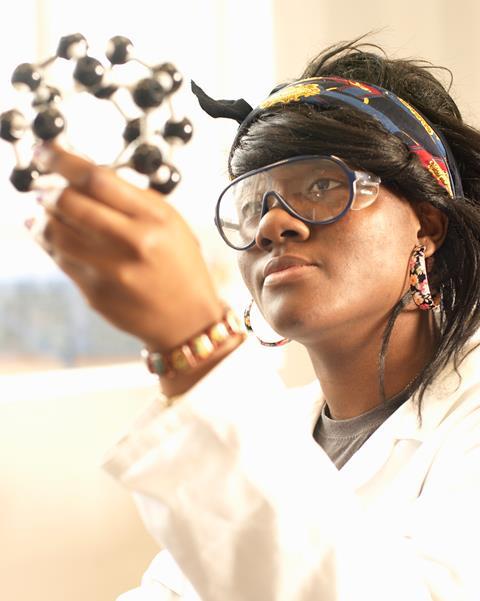Culturally relevant teaching benefits science and students

We recently added an extraction of chlorophyll from spinach leaves to the organic lab curriculum at Spelman College, US. One post-lab question for the experiment asked students to compare chlorophyll and melanin, since they are both common pigments. Of all the pigments we could have picked, we deliberately chose melanin as it has an inherent relevance to our students, Black women. These questions are just one part of my work to develop a chemistry curriculum that includes students of colour and women instead of excluding them.
When I was a chemistry undergraduate and graduate student, I felt excluded from the curriculum and from that I often felt conflicted when I tried to explain what I did to my family or anyone from my small town in south Georgia. As a Black woman, chemistry felt so foreign from my background and how I saw myself. I was never sure how to navigate the area between my chemistry life and my actual life.
I now realise that I did not have the tools to communicate with my family and friends because I didn’t have points of reference that really explained what I did. Of course, my training included communication to different audiences that were academic and non-academic, however, there is nuance in cultural communication that wasn’t captured in the teaching I received, nor insight into intersectionality or my identity as a Black woman.
The curriculum still doesn’t reflect my students’ background or their experiences
More recently, as a professor at a college for Black women, it struck me that the curriculum still doesn’t reflect my students’ background or their experiences. For example, while covering the topic of radicals we encountered a textbook discussion of sunscreen that was meant to provide real-world context. However, it is written from a perspective that focuses on social status, tanning and skin cancer as determinants of societal attitudes towards sunscreen throughout history. It did not include the historical or current perspective of Black people towards sunscreen, including concerns that my students and I have, such as finding sunscreen products that blend into our skin or disputing the misconception that Black people don’t need sunscreen. Although Black people have a much lower chance of developing skin cancer due to melanin, they are often diagnosed with melanoma at later stages due to lack of knowledge about skin cancer and poor training of medical professionals in diagnosing melanoma in individuals with darker skin. So in class, we discussed sunscreen products made specifically for Black people and some students shared their favourite products.
This is an example of culturally relevant teaching, a practice I have used at Spelman to connect chemistry to students’ lives.1 This means that in my lectures and labs, I relate the curriculum to my students’ backgrounds to ensure academic success and support cultural and ethnic attributes of our student population. I design assignments and projects that include culture to help students learn concepts and understand the relevance of chemistry.2 In the laboratory, Beyond the Experiment Modules connect the experiments with applications, careers and student interests and experiences.3 For example, when learning about infrared spectroscopy (IR) students worked in groups to research an application of IR that they found interesting. A viral video of a paper towel dispenser that did not respond to darker skin tones also led to a discussion about IR sensors and why diversity is important when science and technology are integrated. Thus, the students were also exposed to career opportunities that would benefit from their perspectives and experiences.
Culturally relevant teaching also emphasises the need to examine social and political inequities – work that is crucial to advance diversity, equity and inclusion in Stem fields. However, I would be remiss if I didn’t add that this point is also the most challenging to implement. Discrimination and bias still exist in Stem, and is also seen in the public and political opposition to using culture, race and history as teaching points. Thus, bringing about change can be a delicate balance when we involve sociopolitical realities.
Speaking of sociopolitical realities, I will circle back to melanin. Melanin has served as the molecular basis of separation and discrimination in society for centuries. But it is also a group of biopolymers that has applications in cosmetics, pharmaceuticals, biosensors and biomaterials. Melanin is why your avocados and bananas turn brown and neuromelanin, a type of melanin in our brains, is involved in Parkinson’s disease, but we don’t know its full role because the structure and function of most melanins has not been determined. For something so relevant, it is perplexing that we know so little about it, both from a public and scientific perspective. More information on the role of melanin in humans, plants, and animals would allow for insight into Parkinson’s disease, coatings and materials made from melanin or its mimics, and even sustainable semiconductors or fuel cells based on the conducting abilities of melanin.
Some of this research is underway, but not on a large scale. This could be because melanin has an obvious cultural context that may deter some scientists from working in this area, or the limited awareness of the possibilities of melanin research. However, thorough analysis of melanin would demonstrate its ubiquity and tell a story of its untapped potential. If we truly discuss the melanin in the room, it can serve as a tool to advance science and diversity, equity, and inclusion in Stem – the opposite of how it has been used in the past.
References
1 L Winfield et al, Cultivating Agency through the Chemistry and Biochemistry Curriculum at Spelman College. In Broadening Participation in STEM – Effective Pedagogies and Programs for Women and Minorities; G Byrd et al (eds.) Emerald Publishing Limited: Bradford, England, 2019, p153
2 S Johnson, J. Chem. Ed., 2022, 99, 428 (DOI: 10.1021/acs.jchemed.1c00504)
3 S Younge et al, J. Chem. Ed., 2022, 99, 383 (DOI: 10.1021/acs.jchemed.1c00488)












No comments yet